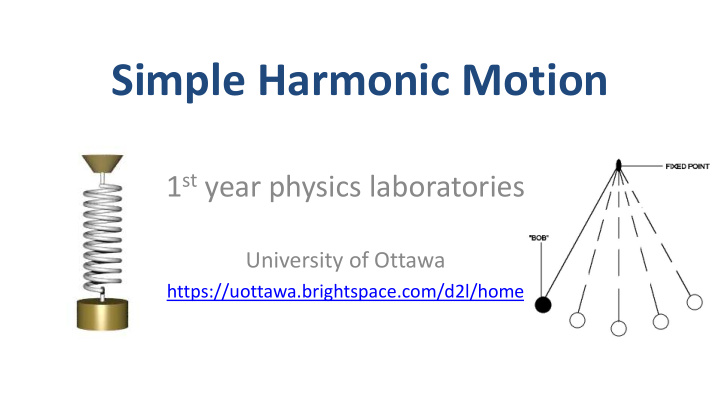



Simple Harmonic Motion 1 st year physics laboratories University of Ottawa https://uottawa.brightspace.com/d2l/home
INTRODUCTION • A mass on a spring will oscillate in simple harmonic motion (SHM). In this experiment you will investigate this type of motion where an object moves back and forth along a fixed path. • If a mass on a spring is pulled down then released, the spring exerts a restoring force, 𝑮 = −𝒍𝒚 , where 𝒚 is the distance the spring is displaced and 𝒍 is the “spring constant” of your spring.
INTRODUCTION (cont.) • For a mass oscillating in SHM on an ideal spring (spring has no 𝒏 mass), the period, T , is given by 𝑼 = 𝟑𝝆 𝒍 . • If the spring has mass, the corrected equation for the period is: 𝑼 = 𝟑𝝆 𝒏 + 𝜹𝒏 𝒕 𝒍 where 𝒏 𝒕 is the mass of the spring and 𝜹 is a constant between 0 and 1 which depends on the type of spring used. • For a regular uniform spring, 𝜹 is equal to 1/3. You will determine the 𝜹 value for the conical harmonic motion spring you will use in this experiment.
OBJECTIVES • Collect position vs. time data for a mass oscillating in SHM on a hanging conical spring and determine the best fit equation for the position vs. time graph. • Relate the variables in your best fit equation to the physical parameters in your system. • Compare the force constant of your spring obtained by static measurements with that found using dynamic measurements. • Estimate the spring’s correction factor, 𝜹 , to calculate the effective mass of your spring.
SAFETY WARNING! • Never hang masses above the motion detector without using the motion detector guard (cage). – Dropping a mass on the detector could cause serious damage to it. • Please do not overstretch the spring beyond its elastic limit. – You need only use small amplitude oscillations (a few cm). • Always find an equilibrium point for your mass on the spring and pull gently to start the oscillations . – Please do not let the masses fall from an arbitrary height to begin oscillations.
PRELIMINARY WORK • Both the force and motion sensors should be connected to your Labquest Mini device. In Logger Pro you should see values for force and position. • The motion detector should be set to “track” and the force sensor set to “10 N”. • Prepare the setup as shown in Fig. 1 (next slide). • Put 300 g on the mass hanger and let it equilibrate, then zero both your sensors. • Collect position vs. time and force vs. time data and fit your curves with a sinusoidal function: A*sin(B*t+C)+D
The setup
The setup (cont.)
Small Amplitude Oscillations
𝒍 from static measurements • Start with an empty mass hanger and zero both your sensors. • Add 100 g to the spring and let it settle. Record the new position, ∆𝑧 , and start filling in Table 2 . • Record the new position as you add mass to the hanger, 100 g at a time. • Prepare your plot of extending force ( F = mg ) vs. position ( ∆𝑧 ).
𝒍 from dynamics measurements • We start with the equation for the period of oscillation and square it: 𝟓𝝆 𝟑 𝒏 𝟓𝝆 𝟑 𝜹𝒏 𝒕 𝑼 𝟑 = 𝒏+𝜹𝒏 𝒕 𝑼 = 𝟑𝝆 + . 𝒍 𝒍 𝒍 • Record position vs. time data for small oscillations of the mass hanger and 100 g on the spring. – Perform a sinusoidal fit of your data and start filling in Table 3 . Recall that B is the angular frequency ( 𝝏 ) of the oscillation. • Record new position vs. time data as you add mass to the hanger, 100 g at a time. Complete Table 3 . • Prepare your graph of T 2 vs. m . (Recall 𝑼 = 𝟑𝝆 𝝏 ).
Investigating Amplitude vs Frequency. • Put 300 g on the mass hanger. • Collect data for different amplitudes of oscillation (different values of ∆𝒛 ) between 0.01 to 0.1 m. • Perform a series of sinusoidal fits for your different runs. • Note the A (amplitude) and B (frequency) values for your different sinusoidal fits and complete Table 4 .
CLEAN UP DUE DATE • Turn off the computer and don’t forget The report is due at the end of the to take your USB key. lab session. • Replace the masses, mass hanger, spring, motion detector, and cage back on the table. • Please recycle scrap paper and throw PRE-LAB away any garbage. Please leave your station as clean as you can. • Push back the monitor, keyboard, and Don’t forget to do your pre -lab mouse. Please push your chair back for the next experiment! under the table. • Thank you!
Recommend
More recommend